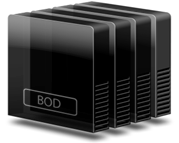 RAID is an acronym for Redundant Array of Independent Disks or originally (redundant array of inexpensive disks) is a storage technology that ensures data integrity by storing the same data on multiple Hard-drives or hard-disks. This helps in increase I/O (Input/Output) operation hence results in better speed and performance. RAID also offers fault tolerance, i.e. System will continue to work even though one or more hard disk drives fail.
RAID is an acronym for Redundant Array of Independent Disks or originally (redundant array of inexpensive disks) is a storage technology that ensures data integrity by storing the same data on multiple Hard-drives or hard-disks. This helps in increase I/O (Input/Output) operation hence results in better speed and performance. RAID also offers fault tolerance, i.e. System will continue to work even though one or more hard disk drives fail.
Basically, RAID is a technology used when there are many hard drives present on the system where if one drive fails the system will continue to work without any data loss. RAID is mainly used for server to maintain data redundancy and Performance.
Why RAID is so Important?
If you are into business having client’s data and other important information on the system with multiple drive without using RAID, then you are at risk of losing all data in case of disk failure. Though you backup at regular interval but still there are data, which might not get backup since hard drive failure is uncertain and can happen at any time. RAID is not all about data protection but also a performance booster.
Choosing right RAID Level for new Array
There are many RAID Levels which can be configured for your new array. However, each RAID level has different functionality i.e either speed or reliability or both. When creating a new array (A group of disks using RAID are called an array), it is important to choose right RAID level. Every RAID level has its advantages and disadvantages, depending on how you want RAID to be.
Choosing an incorrect RAID level might get you in trouble. It all depends on your situation and priorities. If you are running a business where data reliability is very critical and important, in such a case having performance RAID Level will be a high risk for your business.
When choosing RAID Level for a new array, there are number of important points that you must take into consideration, such as Performance, Capacity, Cost and reliability.
Let’s look at some of the common RAID Levels and understand how different RAID Level scores on above four factors.
RAID-0: RAID 0 is all about speed. It provides striping but no redundancy. In RAID 0, data are stored in such a way that it utilizes 100% of hard-disks utilization. The data is spread to multiple drives by splitting & writing the data on both drive instead of using one drive. This overhead increase in performance of read write operation compared to single drive. The downside of RAID 0 is redundancy, If one of the drives in an array fails, then all data across the whole array will be lost. However, in such case data cannot be recovered unless any recovery software is used like raid server data recovery or raid recovery software. Due to its performance and capacity it offers, RAID 0 is considered to be by far the lowest price tag.
RAID-1: Raid 1 is known as Disk mirror since data in drive 1 is mirrored to drive 2 making a full backup of drive 1. This type of RAID Configuration is about data integrity by maintaining the clone of the first drive hence this type of RAID only provides 50% of total capacity of Hard-drive space. Performance will be the same of the single drive. This type would be a perfect for someone looking to secure their data against HDD failure. Considering the fact that this type exactly uses 50% disc usage capacity, which makes it a costlier.
RAID-5: RAID 5 is a bit complicated array which combines benefits of both RAID 0 and RAID 1. This type of configuration requires 3 or more drives, using one drive to improve reliability. Overall capacity usage is considered to be best due to low on one disk usage in an array. In this type, if one drive fails, then it can retrieve the data from other drives in the array. However, if two drives fail at the same time, then whole data in the array is lost. RAID 5 has good performance while reading data due to data taken from multiple drive, however, it suffers a very low performance while writing data due to computation takes place on how data should be written and data parity. Looking out on the performance and reliability it offers at the cost of one extra drive which might be a good deal. However, it is a bit more expensive than RAID 0 and RAID 1.
RAID-10: RAID 10 is a combination of RAID 1 and RAID 0. This type of configuration enjoys both performance of RAID 0 and reliability of RAID 1. It can even survive multiple disk failure, provided that they are not on same side. However, Overall Capacity is 50% of disk usage of an array. The downside to this type is cost, at least 4 drives are required where in two drives are just used for backup of first two drives.
What you think, which is the best RAID when it comes to both Performance and reliability? Share your view on below comment section.

